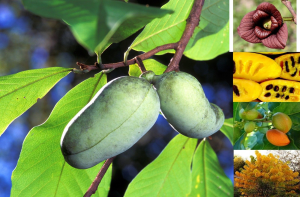Asimina triloba, the American pawpaw, is native to the Eastern, Southern, and Midwestern United States.
The tree commonly grows in floodplains and shady, rich bottomlands, where it often forms a dense, clonally spreading undergrowth in the forest, often appearing as a patch or thicket of individual small slender trees. Pawpaws are not the first to colonize a disturbed site) but may become dominant. Although shade-tolerant, pawpaws do not persist in undisturbed old growth forest.
Pawpaw flowers are insect-pollinated, but fruit production is sometimes limited as few if any pollinators are attracted to the flower’s faint, or sometimes non-existent scent. The flowers produce an odor similar to that of rotting meat to attract blowflies or carrion beetles for cross pollination. Other insects that are attracted to pawpaw flowers include scavenging fruit flies, carrion flies and beetles. Because of irregular fruit production, Asimina pawpaw plants are self-incompatible, requiring cross-pollination between trees of different clones (patches).
The fruits of the pawpaw are eaten by a variety of mammals.
The disagreeable-smelling leaves, twigs, and bark of pawpaws contain natural insecticides known as acetogenins. Pawpaw leaves and twigs are seldom consumed by stock.
The fruit of the pawpaw “looks a bit like mango, but with pale yellow, custardy, spoonable flesh and black, easy-to-remove seeds.” Wild-collected pawpaw fruits, ripe in late Summer to early Autumn, have long been a favorite treat throughout the tree’s extensive native range in eastern North America, and on occasion are sold locally at farmers’ markets. Pawpaw fruits have a sweet, custardish flavor somewhat similar to banana, mango, and cantaloupe, with more protein than most fruits. American agronomist E. Lewis Sturtevant described pawpaws as.. …”a natural custard, too luscious for the relish of most people”.
Ohio botanist William B. Werthner noted that… “The fruit … has a tangy wild-wood flavor peculiarly its own”.
These seeds are imported from the USA from a commercial grower. Two seedlings are required for cross pollination to produce fruit.

